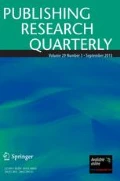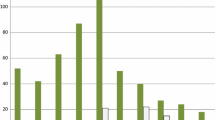Abstract
This article describes some of the characteristics of retracted articles in Arts and Humanities. A total 129 retracted articles in Arts and Humanities journals were identified using Retraction Watch and Scopus and then analyzed. The analysis shows that the main reasons for retracting Arts and Humanities articles is recycling and plagiarism. The analysis also shows that retracted articles continue to be read, downloaded and cited as well as mentioned in social media channels.




Similar content being viewed by others
References
*Note that retracted articles mentioned in this article are not included in the reference list. This is done in order to avoid their continuous citations
Almeida RMV, de Albuquerque Rocha K, Catelani F, Fontes-Pereira AJ, Vasconcelos SM. Plagiarism allegations account for most retractions in major Latin American/Caribbean databases. Sci Eng Ethics. 2016;22(5):1447–56.
Amos KA. The ethics of scholarly publishing: exploring differences in plagiarism and duplicate publication across nations. J Med Libr Assoc: JMLA. 2014;102(2):87.
Bar-Ilan J, Halevi G. Post retraction citations in context: a case study. Scientometrics. 2017;113(1):547–65.
Bar-Ilan J, Halevi G. Temporal characteristics of retracted articles. Scientometrics. 2018;116(3):1771–83.
Biagioli M, Kenney MM, Martin BR, Walsh J. Academic misconduct, misrepresentation and gaming: a reassessment. Res Policy. 2019. https://doi.org/10.1016/j.respol.2018.10.025.
Budd JM, Sievert M, Schultz TR, Scoville C. Effects of article retraction on citation and practice in medicine. Bull Med Libr Assoc. 1999;87(4):437–43.
Casadevall A, Steen RG, Fang FC. Sources of error in the retracted scientific literature. FASEB J. 2014;28(9):3847–55.
Cokol M, Ozbay F, Rodriguez-Esteban R. Retraction rates are on the rise. EMBO Rep. 2008;9(1):2.
Corbyn Z. Misconduct is the main cause of life-sciences retractions. Nature. 2012;490(7418):21.
Decullier E, Huot L, Samson G, Maisonneuve H. Visibility of retractions: a cross-sectional one-year study. BMC Res Notes. 2013;6(1):238.
Fabula É de recherche. Fabula, Atelier littéraire: Plagiat sans fard [Text]. n.d. https://www.fabula.org/atelier.php?Plagiat_sans_fard. Retrieved 13 Nov 2019.
Fanelli D, Costas R, Fang FC, Casadevall A, Bik EM. Why do scientists fabricate and falsify data? A matched-control analysis of papers containing problematic image duplications. 2017. BioRxiv 126805. https://doi.org/10.1101/126805.
Fang FC, Casadevall A. Retracted science and the retraction index. Infect Immun. 2011;79(10):3855–9.
Fang FC, Steen RG, Casadevall A. Misconduct accounts for the majority of retracted scientific publications. Proc Natl Acad Sci. 2012;109(42):17028–33.
Gasparyan AY, Ayvazyan L, Akazhanov NA, Kitas GD. Self-correction in biomedical publications and the scientific impact. Croat Med J. 2014;55(1):61.
Glänzel W, Braun T, Schubert A, Zosimo-Landolfo G. Coping with copying. Scientometrics. 2015;102(1):1–3.
Lariviere V, Gingras Y. On the prevalence and scientific impact of duplicate publications in different scientific fields (1980–2007). J Doc. 2010;66(2):179–90.
Madlock-Brown CR, Eichmann D. The (lack of) impact of retraction on citation networks. Sci Eng Ethics. 2014;21(1):127–37.
Marcus A, Oransky I. What studies of retractions tell us. J Microbiol Biol Educ. 2014;15(2):151.
Masic I. Plagiarism in scientific publishing. Acta Inform Medica. 2012;20(4):208.
Overlapping publications and self-plagiarism – Forskerportalen.dk. n.d. https://forskerportalen.dk/en/overlapping-publications-and-self-plagiarism/. Retrieved 28 Aug 2019.
Retraction Watch Database. n.d. http://retractiondatabase.org/RetractionSearch.aspx?. Retrieved 18 Jan 2019.
Smart P, Gaston T. How prevalent are plagiarized submissions? Global survey of editors. Learn Publ. 2019;32(1):47–56.
Steen RG. Retractions in the scientific literature: do authors deliberately commit research fraud? J Med Ethics. 2011;37(2):113–7.
Williams P, Wager E. Exploring why and how journal editors retract articles: findings from a qualitative study. Sci Eng Ethics. 2013;19(1):1–11.
Author information
Authors and Affiliations
Corresponding author
Additional information
Publisher's Note
Springer Nature remains neutral with regard to jurisdictional claims in published maps and institutional affiliations.
Rights and permissions
About this article
Cite this article
Halevi, G. Why Articles in Arts and Humanities Are Being Retracted?. Pub Res Q 36, 55–62 (2020). https://doi.org/10.1007/s12109-019-09699-9
Published:
Issue Date:
DOI: https://doi.org/10.1007/s12109-019-09699-9




